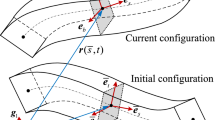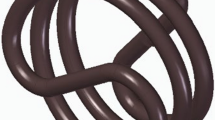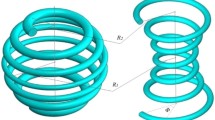Abstract
Helical springs are indispensable elements in mechanical engineering. This paper investigates helical springs subjected to axial loads under different dynamic conditions. The mechanical system, composed of a helical spring and two blocks, is considered and analyzed. Multibody system dynamics theory is applied to model the system, where the spring is modeled by Euler–Bernoulli curved beam elements based on an absolute nodal coordinate formulation. Compared with previous studies, contact between the coils of spring is considered here. A three-dimensional beam-to-beam contact model is presented to describe the interaction between the spring coils. Numerical analysis provides details such as spring stiffness, static and dynamic stress for helical spring under compression. All these results are available in design of helical springs.











Similar content being viewed by others
References
Becker LE, Chassie GG, Cleghorn WL (2002) On the natural frequencies of helical compression springs. Int J Mech Sci 44:825–841. doi:10.1016/S0020-7403(01)00096-0
Yildirim V (2002) Expressions for predicting fundamental natural frequencies of non-cylindrical helical springs. J Sound Vib 252:479–491. doi:10.1006/jsvi.2001.400
Stokes VK (2002) On the dynamic radial expansion of helical springs due to longitudinal impact. J Sound Vib 35:77–99
Fakhreddine D, Mohamed T, Said A, Abderrazek D, Mohamed H (2005) Finite element method for the stress analysis of isotropic cylindrical helical spring. Eur J Mech A, Solids 24:1068–1078. doi:10.1016/j.euromechsol.2005.07.002
Becker LE, Cleghorn WL (1992) On the buckling of helical compression springs. Int J Mech Sci 34:275–282. doi:10.1016/0020-7403(92)90035-F
Chassie GG, Becker LE, Cleghorn WL (1997) On the buckling of helical springs under combined compression and torsion. Int J Mech Sci 39:697–704
Della Pietra L, Della Valle S (1982) On the dynamic behaviour of axially excited helical springs. Meccanica 17:31–43. doi:10.1007/BF02156005
Kim D (1999) Development of a finite element program for dynamic analysis of helical springs. In: Proceedings of the third Russian-Korean international symposium on science and technology, vol 1, pp 309–314
Pietra L (1976) The dynamic coupling of torsional and flexural strains in cylindrical helical springs. Meccanica 11:102–119. doi:10.1007/BF02138004
Jiang WG, Henshall JL (2000) A novel finite element model for helical springs. Finite Elem Anal Des 35:363–377
Schwab AL, Meijaard JP (2010) Comparison of three dimensional flexible beam elements for dynamic analysis: classical finite element formulation and absolute nodal coordinate formulation. J Comput Nonlinear Dyn 5:1–10
Gerstmayr J, Shabana AA (2006) Analysis of thin beams and cables using the absolute nodal coordinate formulation. Nonlinear Dyn 45:109–130. doi:10.1007/s11071-006-1856-1
Sopanen JT, Mikkala AM (2003) Description of elastic forces in absolute nodal coordinate formulation. Nonlinear Dyn 34:53–74
Wriggers P, Zavarise G (1997) On contact between three-dimensional beams undergoing large deflections. Commun Numer Methods Eng 13:429–438
Zavarise G, Wriggers P (2000) Contact with friction between beams in 3-D space. Int J Numer Methods Eng 49:997–1006
Von Dombrowski S (2002) Analysis of large flexible body deformation in multibody systems using absolute coordinates. Multibody Syst Dyn 8:409–432. doi:10.1023/A:1021158911536
Sugiyama H, Suda Y (2007) A curved beam element in the analysis of flexible multi-body systems using the absolute nodal coordinates. Proc Inst Mech Eng, Proc, Part K, J Multi-Body Dyn 221:219–231. doi:10.1243/1464419JMBD86
Sugiyama H, Koyama H, Yamashita H (2010) Gradient deficient curved beam element using the absolute nodal coordinate formulation. J Comput Nonlinear Dyn 5:021001. doi:10.1115/1.4000793
Gerstmayr J, Irschik H (2008) On the correct representation of bending and axial deformation in the absolute nodal coordinate formulation with an elastic line approach. J Sound Vib 318:1129–1149. doi:10.1016/j.jsv.2008.04.019
Carrera E, Petrolo M (2012) Refined beam elements with only displacement variables and plate/shell capabilities. Meccanica 47:537–556
Bambill DV, Rossit CA, Rossi RE, Felix DH, Ratazzi AR (2013) Transverse free vibration of non uniform rotating Timoshenko beams with elastically clamped boundary conditions. Meccanica 48:1289–1311
Yang CJ (2010) Multibody dynamic modeling and simulation for full-hole drilling system. PhD thesis, Tsinghua University
Vallejo DG, Valverde J, Dominguez J (2005) An internal damping model for the absolute nodal coordinate formulation. Nonlinear Dyn 42:347–369
Wahl AM (1963) Mechanical springs, 2rd edn. McGraw-Hill, New York
Calder GA, Jenkins C (1988) Stress analysis of a helical coil automobile spring using rosettes. Exp Tech 12:17–20
Acknowledgements
Grant support from the China Postdoctoral Science Foundation (2013M542290) for this work is highly appreciated. This work was also supported by the Key Research Fund of Xihua University (Z1020212) and by the Research Fund of Key Laboratory of Manufacturing and Automation of Sichuan Province (SZjj2011-016). The authors would also like to thank anonymous editors and reviewers for their constructive and detailed comments on improving this paper.
Author information
Authors and Affiliations
Corresponding author
Rights and permissions
About this article
Cite this article
Yang, C.J., Zhang, W.H., Ren, G.X. et al. Modeling and dynamics analysis of helical spring under compression using a curved beam element with consideration on contact between its coils. Meccanica 49, 907–917 (2014). https://doi.org/10.1007/s11012-013-9837-1
Received:
Accepted:
Published:
Issue Date:
DOI: https://doi.org/10.1007/s11012-013-9837-1




